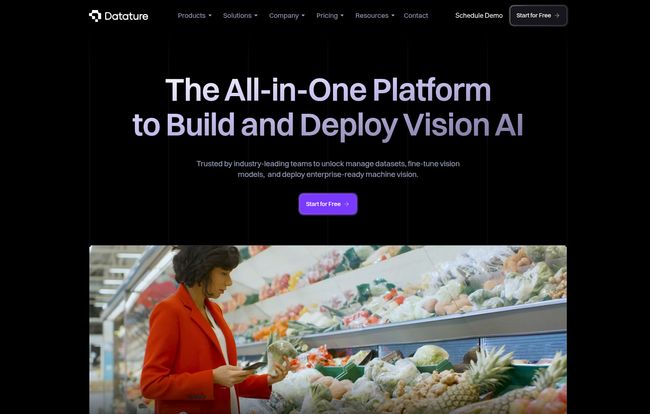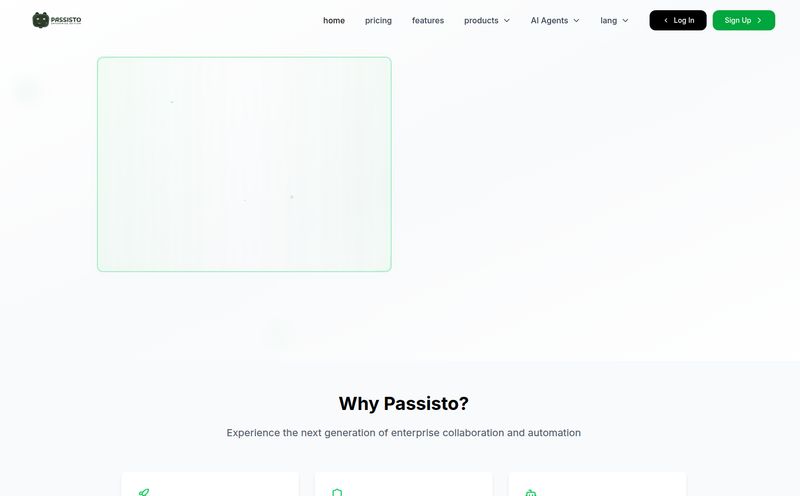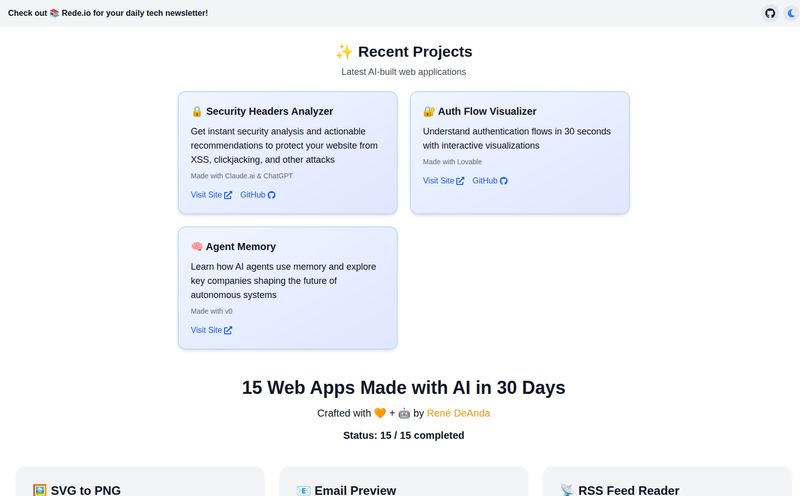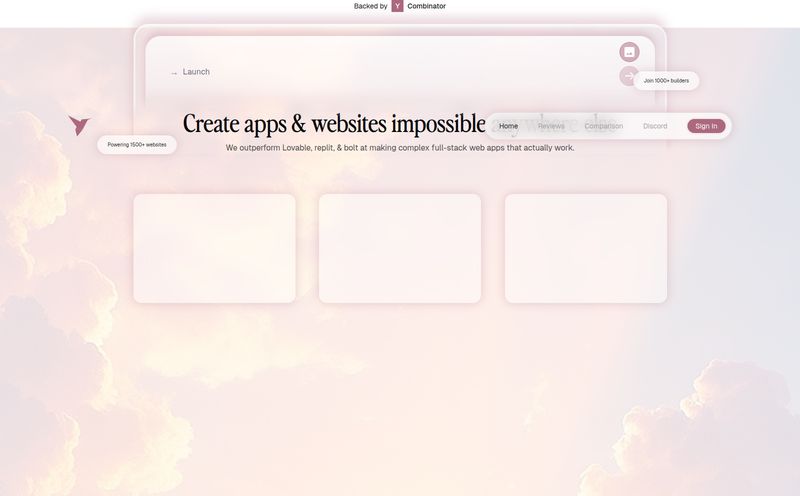For years, I've been neck-deep in the worlds of SEO, traffic, and all things digital. A big part of that has been watching the AI space explode. And within that explosion, computer vision has always felt like this magical, slightly out-of-reach frontier. It’s powerful, it’s transformative, but man, is it a pain to get started with. The setup, the coding, the endless tweaking... it's a huge barrier to entry.
I’ve seen a lot of tools come and go, each promising to be “the one.” The one to finally democratize AI development. Most of them are… fine. They’ll do one thing well, like annotation, but then leave you stranded when it comes to training or deployment. It’s like being sold a fancy engine with no car attached.
So, when I started hearing whispers about Datature, an “all-in-one no-code platform,” my seasoned skepticism kicked in. Another one? But I kept digging, and what I found was genuinely interesting. This might just be different. So, I’m putting on my blogger hat to give you my honest-to-goodness take on it.
So, What Exactly is Datature?
On the surface, Datature bills itself as a no-code AI vision platform. Simple enough. But that doesn't really capture the scope of it. I think of it less as a single tool and more as a complete workbench for your computer vision projects. It’s designed to hold your hand through the entire chaotic process, from a messy folder of images to a fully deployed, working AI model.
It handles the whole pipeline: managing your datasets, annotating them (the part everyone hates), training the models, and then actually getting them out into the real world. It’s an ambitious goal, trying to wrap up what is usually four or five different, clunky software solutions into one polished package. The big question is, do they pull it off?
Walking Through The Entire Vision AI Pipeline
The biggest selling point here is the end-to-end workflow. Let’s break down how Datature handles each stage, because this is where the magic (or lack thereof) really happens.
First, Taming Your Datasets
Anyone who has worked on an AI project knows that 80% of your time is spent just wrestling with data. It’s a mess of collecting, sorting, cleaning, and versioning. Datature provides a centralized hub for this. You can upload your images and videos, organize them, and keep track of everything without wanting to tear your hair out. It’s the kind of un-sexy, quality-of-life feature that veterans of the field will immediately appreciate. No more 'dataset_final_v2_revised_FINAL.zip' nonsense.
Annotation That Doesn't Feel Like a Chore
Ugh, annotation. Bounding boxes, polygons, keypoints... it's tedious, mind-numbing work. Datature seems to get this. They've built in what they call “Intelligent Tools,” which is a fancy way of saying AI-assisted labeling. Think of tools that can predict the box you're about to draw or automatically segment an object. It’s not perfect, but it can turn a ten-hour job into a three-hour one. They also have collaborative features, so you can bring in your team to share the load. A godsend for larger projects.

Visit Datature
Model Training Without the PhD in Math
This is the core of the “no-code” promise. Traditionally, you'd be wrestling with TensorFlow or PyTorch, writing Python scripts, and crying over CUDA driver compatibility issues. Been there, done that, got the t-shirt.
With Datature, you select your annotated dataset, choose a model type (like Object Detection or Instance Segmentation), and hit a 'train' button. The platform handles the complex stuff—the model architectures, the data augmentation, the hyperparameter tuning—in the background. Now, some hardcore data scientists might scoff at this. “You’re losing control!” And they’re not entirely wrong. But for 90% of use cases? This is more than enough. It lets you focus on the problem you're trying to solve, not the intricacies of a neural network.
Deployment That Actually Works
A trained model sitting on your hard drive is useless. The final, and often most painful, step is deploying it. Datature offers a few paths here. You can get a simple API endpoint to send images to and get predictions back, or you can export the model in various formats (like ONNX or TFLite) to run on your own hardware or edge devices. This flexibility is a huge plus, preventing total vendor lock-in.
Who is This Really For?
I see a few key groups getting a ton of value here. First, startups and small teams who need to build a proof-of-concept fast without hiring a dedicated MLOps engineer. Second, researchers and academics who want to test hypotheses without getting bogged down in the engineering. And finally, larger enterprise teams that need a standardized platform to streamline their workflow and ensure everyone is on the same page.
The platform seems to scale with you, which is smart. You can start as a lone developer tinkering on a passion project and grow into a full team deploying at scale, all within the same ecosystem.
Okay, Let's Talk Money: Datature's Pricing
Price is always the elephant in the room. Datature uses a tiered model, which I've broken down into a simple table. It's pretty straightforward, but the devil is in the details of the quotas.
| Plan | Price | Best For | Key Features |
|---|---|---|---|
| Developer | Free | Individuals, Researchers, Hobbyists | 5,000 assets, 10,000 annotations/month, basic annotation tools, 2 projects. It's a very generous free tier. |
| Professional | $299/mo (annually) or $499/mo (monthly) | Teams, Startups, Professional Use | 200,000 assets, 400,000 annotations/month, advanced tools, collaboration, more training hours. |
| Enterprise | Custom | Large organizations with specific security, support, or deployment needs. | Everything in Professional plus private cloud/on-prem deployment, custom SSO, dedicated support. |
My take? The Developer plan is fantastic for getting your feet wet. The jump to Professional is significant, but for a team building a commercial product, the cost is easily justified by the time savings. It's cheaper than hiring another engineer, that's for sure.
The Good, The Bad, and The... Coming Soon
No tool is perfect, and a review isn't honest without looking at both sides of the coin.
What I Genuinely Like
The biggest pro is the cohesiveness. Having every tool you need under one roof eliminates so much friction. The UI is clean, the workflow makes sense, and it massively lowers the barrier to entry for building powerful AI applications. The developer-friendly aspects, like the API and model export options, show they haven't forgotten about the power users, which I respect. It strikes a good balance.
A Few Things to Keep in Mind
Of course, there are trade-offs. By using a platform like this, you are putting a lot of your eggs in one basket. You become reliant on Datature's infrastructure, their model library, and their uptime. For some, that's a deal-breaker. Also, as with many growing platforms, you'll spot a few "Coming Soon" labels on certain features. This is exciting because it shows they're developing, but also a little frustrating if the one feature you really need isn't quite there yet. The custom pricing for Enterprise can also be a bit of a black box, which always makes procurement teams a little nervous.
My Final Verdict on Datature
So, is Datature the platform I've been waiting for? It's damn close.
It successfully tackles the biggest challenge in applied AI: it makes the entire process accessible and manageable. It’s not going to replace the brilliant data scientists at Google Brain, but it was never meant to. It’s meant for the rest of us—the developers, the product managers, the entrepreneurs who have a great idea for using vision AI but don't have the time or resources to build everything from scratch.
It's a powerful enabler. It lets you go from idea to prototype in days, not months. And in the fast-moving world of tech, that speed is everything. It might not be perfect, but it represents a significant step in the right direction for making AI a tool that more people can build with. And I’m all for that.
Frequently Asked Questions About Datature
- Is Datature really a "no-code" platform?
- For the core workflow of annotation and training, yes. You can build a model without writing code. However, to integrate that model into your own application, you'll likely use their API or SDK, which does involve some coding. It's more like "low-code" for the full integration.
- What kinds of computer vision models can I build?
- Datature supports the mainstays of computer vision: Image Classification (what is in the image?), Object Detection (where are the objects?), and both Instance and Semantic Segmentation (which pixels belong to which object?). This covers a huge range of real-world applications.
- How generous is the free 'Developer' plan?
- Very. With support for 5,000 images and 10,000 annotations per month, it's more than enough for any individual to learn the platform, build several proof-of-concept models, and even run a small-scale personal project. It’s one of hte better free tiers I've seen.
- Can I get my data and models out of the platform?
- Yes. This is a big plus. You can export your annotations in common formats like COCO and YOLO, and you can export your trained models to run them independently. This helps mitigate the risk of being completely locked into their platform.
- Is Datature a good fit for large, sensitive enterprise projects?
- It can be, especially with their Enterprise plan. This plan offers options for private cloud or even on-premise deployment, meaning your sensitive data never has to leave your own infrastructure. This is critical for industries like healthcare or defense.
Wrapping It Up
Look, the world of AI tools is crowded. But Datature stands out by focusing on a single, coherent workflow that just makes sense. It removes the most tedious parts of computer vision development and lets you focus on building something cool. If you've ever had an idea for a vision AI app but were intimidated by the technical hurdles, you owe it to yourself to sign up for their free plan and give it a spin. You might be surprised at what you can build.



